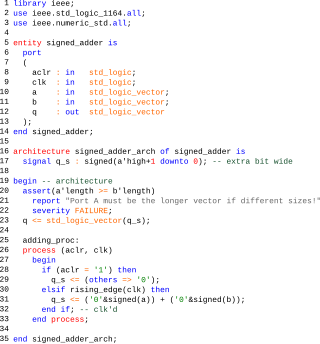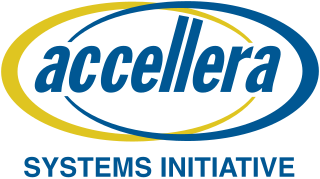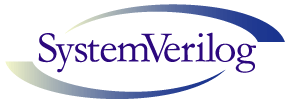Related Research Articles

The VHSIC Hardware Description Language (VHDL) is a hardware description language (HDL) that can model the behavior and structure of digital systems at multiple levels of abstraction, ranging from the system level down to that of logic gates, for design entry, documentation, and verification purposes. Since 1987, VHDL has been standardized by the Institute of Electrical and Electronics Engineers (IEEE) as IEEE Std 1076; the latest version of which is IEEE Std 1076-2019. To model analog and mixed-signal systems, an IEEE-standardized HDL based on VHDL called VHDL-AMS has been developed.
Verilog, standardized as IEEE 1364, is a hardware description language (HDL) used to model electronic systems. It is most commonly used in the design and verification of digital circuits at the register-transfer level of abstraction. It is also used in the verification of analog circuits and mixed-signal circuits, as well as in the design of genetic circuits. In 2009, the Verilog standard was merged into the SystemVerilog standard, creating IEEE Standard 1800-2009. Since then, Verilog has been officially part of the SystemVerilog language. The current version is IEEE standard 1800-2023.
In computer engineering, a hardware description language (HDL) is a specialized computer language used to describe the structure and behavior of electronic circuits, most commonly to design ASICs and program FPGAs.
The IEEE 1164 standard is a technical standard published by the IEEE in 1993. It describes the definitions of logic values to be used in electronic design automation, for the VHDL hardware description language. It was sponsored by the Design Automation Standards Committee of the Institute of Electrical and Electronics Engineers (IEEE). The standardization effort was based on the donation of the Synopsys MVL-9 type declaration.
Property Specification Language (PSL) is a temporal logic extending linear temporal logic with a range of operators for both ease of expression and enhancement of expressive power. PSL makes an extensive use of regular expressions and syntactic sugaring. It is widely used in the hardware design and verification industry, where formal verification tools and/or logic simulation tools are used to prove or refute that a given PSL formula holds on a given design.

Accellera Systems Initiative (Accellera) is a standards organization that supports a mix of user and vendor standards and open interfaces development in the area of electronic design automation (EDA) and integrated circuit (IC) design and manufacturing. It is less constrained than the Institute of Electrical and Electronics Engineers (IEEE) and is therefore the starting place for many standards. Once mature and adopted by the broader community, the standards are usually transferred to the IEEE.
In computer engineering, logic synthesis is a process by which an abstract specification of desired circuit behavior, typically at register transfer level (RTL), is turned into a design implementation in terms of logic gates, typically by a computer program called a synthesis tool. Common examples of this process include synthesis of designs specified in hardware description languages, including VHDL and Verilog. Some synthesis tools generate bitstreams for programmable logic devices such as PALs or FPGAs, while others target the creation of ASICs. Logic synthesis is one step in circuit design in the electronic design automation, the others are place and route and verification and validation.
In electronic design, a semiconductor intellectual property core, IP core, or IP block is a reusable unit of logic, cell, or integrated circuit layout design that is the intellectual property of one party. IP cores can be licensed to another party or owned and used by a single party. The term comes from the licensing of the patent or source code copyright that exists in the design. Designers of system on chip (SoC), application-specific integrated circuits (ASIC) and systems of field-programmable gate array (FPGA) logic can use IP cores as building blocks.

SystemVerilog, standardized as IEEE 1800, is a hardware description and hardware verification language used to model, design, simulate, test and implement electronic systems. SystemVerilog is based on Verilog and some extensions, and since 2008, Verilog is now part of the same IEEE standard. It is commonly used in the semiconductor and electronic design industry as an evolution of Verilog.

Integrated circuit design, or IC design, is a sub-field of electronics engineering, encompassing the particular logic and circuit design techniques required to design integrated circuits, or ICs. ICs consist of miniaturized electronic components built into an electrical network on a monolithic semiconductor substrate by photolithography.
Verilog-AMS is a derivative of the Verilog hardware description language that includes Analog and Mixed-Signal extensions (AMS) in order to define the behavior of analog and mixed-signal systems. It extends the event-based simulator loops of Verilog/SystemVerilog/VHDL, by a continuous-time simulator, which solves the differential equations in analog-domain. Both domains are coupled: analog events can trigger digital actions and vice versa.
C to HDL tools convert C language or C-like computer code into a hardware description language (HDL) such as VHDL or Verilog. The converted code can then be synthesized and translated into a hardware device such as a field-programmable gate array. Compared to software, equivalent designs in hardware consume less power and execute faster with lower latency, more parallelism and higher throughput. However, system design and functional verification in a hardware description language can be tedious and time-consuming, so systems engineers often write critical modules in HDL and other modules in a high-level language and synthesize these into HDL through C to HDL or high-level synthesis tools.
Aldec, Inc. is a privately owned electronic design automation company based in Henderson, Nevada that provides software and hardware used in creation and verification of digital designs targeting FPGA and ASIC technologies.
Unified Power Format (UPF) is the popular name of the Institute of Electrical and Electronics Engineers (IEEE) standard for specifying power intent in power optimization of electronic design automation. The IEEE 1801-2009 release of the standard was based on a donation from the Accellera organization. The current release is IEEE 1801-2018.
VHDL-AMS is a derivative of the hardware description language VHDL. It includes analog and mixed-signal extensions (AMS) in order to define the behavior of analog and mixed-signal systems.
Within computing, the Rosetta system-level specification language is a design language for complex, heterogeneous systems. Specific language design objectives include:
MyHDL is a Python-based hardware description language (HDL).
High-level synthesis (HLS), sometimes referred to as C synthesis, electronic system-level (ESL) synthesis, algorithmic synthesis, or behavioral synthesis, is an automated design process that takes an abstract behavioral specification of a digital system and finds a register-transfer level structure that realizes the given behavior.
This page is a comparison of electronic design automation (EDA) software which is used today to design the near totality of electronic devices. Modern electronic devices are too complex to be designed without the help of a computer. Electronic devices may consist of integrated circuits (ICs), printed circuit boards (PCBs), field-programmable gate arrays (FPGAs) or a combination of them. Integrated circuits may consist of a combination of digital and analog circuits. These circuits can contain a combination of transistors, resistors, capacitors or specialized components such as analog neural networks, antennas or fuses.
This is a list of the individual topics in Electronics, Mathematics, and Integrated Circuits that together make up the Computer Engineering field. The organization is by topic to create an effective Study Guide for this field. The contents match the full body of topics and detail information expected of a person identifying themselves as a Computer Engineering expert as laid out by the National Council of Examiners for Engineering and Surveying. It is a comprehensive list and superset of the computer engineering topics generally dealt with at any one time.
References
- ↑ "The Design Automation Standards Committee". official web site. IEEE. Archived from the original on July 25, 2011. Retrieved August 13, 2011.
- ↑ "DASC Working Groups". Archived from the original on 2009-04-12. Retrieved 2013-07-10.
- ↑ "DASC Working Groups". Archived from the original on 2013-09-01. Retrieved 2013-07-10.
- "Procedures for IEEE Computer Society Design Automation Standards Committee". Design Automation Standards Committee.
- Moretti, Gabe (2007-03-16). "DASC approves low power format PAR". EE Times .